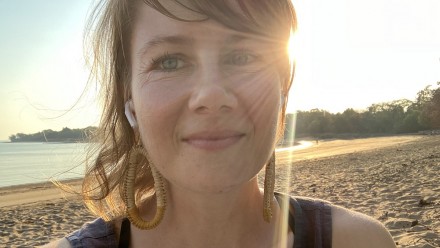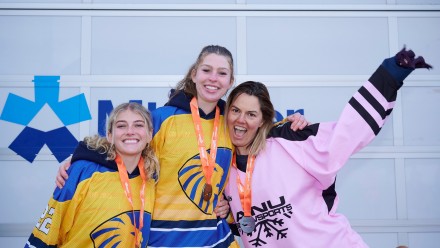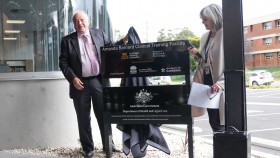Simulated emergency: a unique learning opportunity for medical students
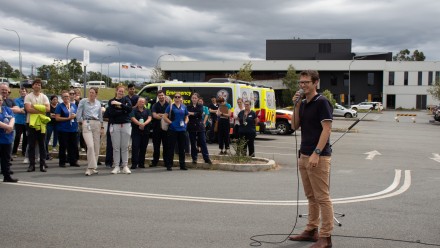 The car accident victim is found and emergency services are called
The car accident victim is found and emergency services are called
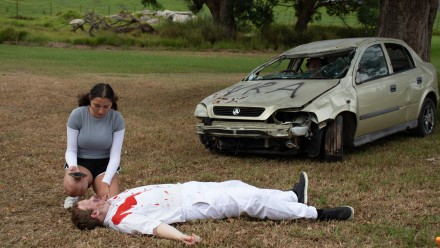 Emergency services arrive at the scene
Emergency services arrive at the scene
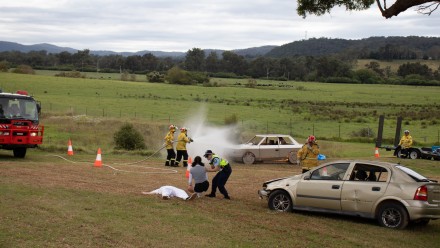 Emerency services get to work to extricate, triage and stabilise the patients
Emerency services get to work to extricate, triage and stabilise the patients
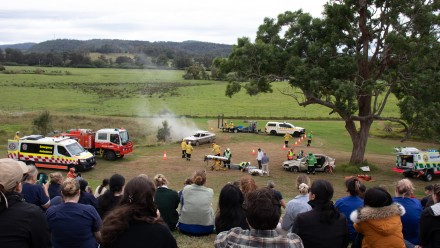 Emergency services working to stablise and then transport the patients to hospital
Emergency services working to stablise and then transport the patients to hospital
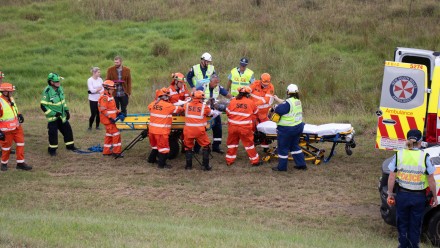 At the hospital, medical students receive the patient and get to work
At the hospital, medical students receive the patient and get to work
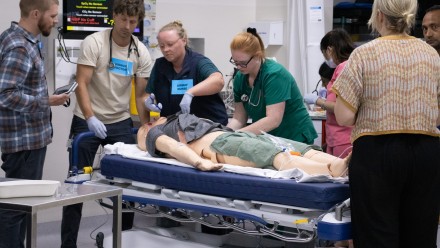
Picture this, you’re driving along a quiet rural road and you come across a car on fire with people trapped inside. One is conscious the other is not. What would you do?
This type of simulated scenario is one of many activities that medical students may participate in as part of their induction to rural medicine in year 1 of the medical program at the Australian National University (ANU).
Rural Week is held across all locations of the Rural Clinical School, including the Cooma, Eurobodalla, Young/Cowra, Goulburn and Bega nodes, with students allocated to attend one of the six locations. Other activities that students participate in include learning to apply plaster casts, practising suturing using pig trotters, and undertaking blood pressure checks.
A large scale multi-agency emergency simulation exercise in Bega has grown considerably over the years and now includes collaboration with most local emergency services such as the police, fire brigade, ambulance, medevac helicopter, and doctors and nurses at the local hospital.
Students experience how emergency teams work together to prepare for real-life trauma management in a controlled environment.
Dr Nathan Oates, a Lecturer for the ANU Rural Clinical School and overall coordinator for the exercise in Bega said, “In the case of a car accident, the role of the emergency services team is to extricate, triage, stabilise and transport to hospital.”
“The team will phone the hospital and provide details about the incoming patients. Based on the situation, the hospital will decide whether to assemble a trauma team at the receiving hospital.”
“In some circumstances, the retrieval helicopter will intercept the emergency services and patient at the roadside and stabilise and transport the patient from there.”
Before the simulation takes place, students spend time rotating between each emergency service team to understand the role the group plays in the response process.
Each year the ANU Rural Clinical School, along with the local emergency services teams, aim to make the simulation exercise more realistic and challenging for the students.
This year, there was the inclusion of fire as part of the exercise and the utilisation of a ‘mule’ to transport the car crash victim out of a ravine where access was difficult.
The exercise in Bega has grown to include University of Canberra (nursing students) and Wollongong (nursing and medicine students), as well as local high school students.
In addition, a current year 2 student is undertaking an evaluation of the event as part of their research project to measure the engagement and educational value of the simulated exercise to ensure continuous improvement.
The innovative simulation exercise resulted in members of the Rural Clinical School and others in Bega being nominated for the SNSWLDH Excellence Awards - Delivering Integrated Care held in June, which recognises leadership and education in rural healthcare.
Congratulations to the team:
Overall Coordination
- Dr Nathan Oates, South East Regional Hospital and RCS Bega, ANU School of Medicine and Psychology
- Dr Shakeeb Bani Yaseen, Canberra Health Service
- Deborah Ferguson, RCS Bega, ANU School of Medicine and Psychology
Agencies
- Phillip Krucler, NSW Ambulance Service
- Chris Anderson, Phil Banks, RFS
- Michelle De Friskbom, Janice Brown, John Mills, NSW State Emergency Service
- Zac Willis, Steve Odell, VRA
- Kate Whitton, NSW Police
Faculty - Simulation
- Brad Leeson, University of Canberra
- Jo Somerville, SERH
- Michael Grew, SERH
- EMET team, Canberra Health Service
- Sinisa Nesic, ANU School of Medicine and Psychology
Facilitators at Clinical Training Facility
- Dr Duncan MacKinnon, SERH and SMP Rural Clinical School
- Dr Erika Jaensch, SMP Rural Clinical School
- Prof Sally Hall Dykgraaf, Head, SMP Rural Clinical School
- Emily Detourettes, Jessie Austin, University of Wollongong





